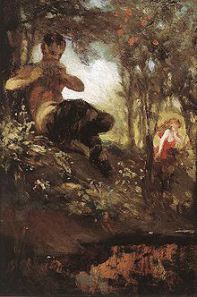A Thing or Two About Fauns and Satyrs
Satyrs and fauns began as creatures very different from each other. The faun was half-man, half-goat, and the satyr was depicted as a hairy, stocky dwarf. But eventually the Romans noted some of the similarities between their fauns and the Greek satyrs, and over the years the features and characteristics of the two began to blend.
Satyrs are associated with the god Dionysus. Fauns are more often associated with the god Pan (or Faunus).
When it comes to partying, fauns love to dance and play music on flutes and tambourines. Satyrs, however, party a bit harder. They have a strong fondness for wine, and tend to chase women …
a strong fondness for wine, and tend to chase women …
Satyrs tend to laugh at everything, and hold nothing in reverence. Their name is where the word “satire” originated from.
Fauns are more low-key and peaceful than their raucous satyr cousins. They generally prefer to live in harmony with nature and others.
The god Pan (and its Roman counterpart Faunus) was a satyr, the god of all wild creatures. It’s said that his temper could inspire pan-ic in all who heard him.
Both satyrs and fauns are usually depicted with horns, although some say a faun has natural horns, whereas a satyrs has to earn his.
Fauns are forest dwellers, and have sometimes been known to be guides to humans.
Satyrs are mischief-makers, but are also generally thought to be more knowledgeable than fauns.
When satyrs arrived at an advanced age, they are referred to as Sileni.
Sometimes shepherds would sacrifice the firstlings of their flocks to satyrs, but more commonly they would just offer grapes or apples. They would also make songs addressed to satyrs in hopes of appeasing them.
The writer, Horace, claimed that Faunus (the father of fauns) was the guardian and protector of men of wit. Virgil says that Faunus was a god of oracles and predictions.
Tumnus in The Lion, the Witch and the Wardrobe by C.S. Lewis (faun).
Grover Underwood in the Percy Jackson series by Rick Riordan (satyr).
Satyrs feature in Fablehaven by Brandon Mull.
A satyr carved into the door of a cabinet is a character in Hans Christian Andersen’s “The Shepherdess and the Sweep.”
In Peter S. Beagle’s The Last Unicorn, the Satyr is one of the Creatures of the Night, Brought to Light.


Satyrs are associated with the god Dionysus. Fauns are more often associated with the god Pan (or Faunus).
When it comes to partying, fauns love to dance and play music on flutes and tambourines. Satyrs, however, party a bit harder. They have
 a strong fondness for wine, and tend to chase women …
a strong fondness for wine, and tend to chase women …Satyrs tend to laugh at everything, and hold nothing in reverence. Their name is where the word “satire” originated from.
Fauns are more low-key and peaceful than their raucous satyr cousins. They generally prefer to live in harmony with nature and others.
The god Pan (and its Roman counterpart Faunus) was a satyr, the god of all wild creatures. It’s said that his temper could inspire pan-ic in all who heard him.
Both satyrs and fauns are usually depicted with horns, although some say a faun has natural horns, whereas a satyrs has to earn his.
Fauns are forest dwellers, and have sometimes been known to be guides to humans.
Satyrs are mischief-makers, but are also generally thought to be more knowledgeable than fauns.
When satyrs arrived at an advanced age, they are referred to as Sileni.
Sometimes shepherds would sacrifice the firstlings of their flocks to satyrs, but more commonly they would just offer grapes or apples. They would also make songs addressed to satyrs in hopes of appeasing them.
The writer, Horace, claimed that Faunus (the father of fauns) was the guardian and protector of men of wit. Virgil says that Faunus was a god of oracles and predictions.
Fauns and Satyrs in Literature:
Tumnus in The Lion, the Witch and the Wardrobe by C.S. Lewis (faun).
Grover Underwood in the Percy Jackson series by Rick Riordan (satyr).
Satyrs feature in Fablehaven by Brandon Mull.
A satyr carved into the door of a cabinet is a character in Hans Christian Andersen’s “The Shepherdess and the Sweep.”
In Peter S. Beagle’s The Last Unicorn, the Satyr is one of the Creatures of the Night, Brought to Light.


Published on October 13, 2014 06:00
No comments have been added yet.



